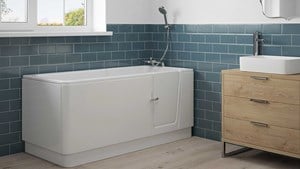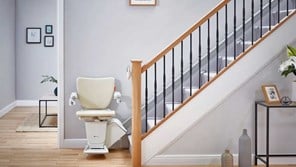How to future-proof your home for independence
6 minute read

Mobility products such as grab rails and stairlifts can help provide independence in later life. But how easy is it to install them in your home and how much does it cost? We speak to some mobility and insurance experts to find out more.

Independent Living Solutions
Home mobility aids, wearable alarms and personal care products to help you live independently, stay safe and feel confident.
With new mobility products being developed all the time, independent living in later life is more accessible than ever. Research firm Global Market Insights expects the mobility solutions market to grow from £95 billion in 2022 to £8.7 trillion in 2032 [1].
There is a wide range of mobility aids available, from basic grab bars to complex solutions like stairlifts and accessible bathrooms. Most products are straightforward to install, but it can be difficult to know where to start or what to consider. To help navigate the process, we consulted experts for their insights and guidance.
Where to begin and will I need planning permission?
It makes sense to begin with rooms that are essential for daily activities, explains Matt Roberts, who works for Handicare, Age Co’s chosen provider of stairlifts and bathing solutions.
The bathroom is a popular room to start. Bathing solutions include walk-in bathtubs, accessible showers and wet rooms. “Retrofitting the bathroom with bathing solutions ensures a safer and more accessible personal care routine,” says Matt.
He says stairlifts and home lifts are often among the first items to consider as they can help eliminate everyday mobility challenges. He explains the differences between the two solutions.
Stairlifts and home lifts
Some people prefer home lifts, as they can make transporting heavy items between floors easier. And with home lifts there are some options for wheelchairs. But you will need a suitable space available for a home lift. Imagine a miniature lift cabin, with a glass window that can glide smoothly between floors in your home. In comparison, a stairlift fits into the existing stair area.
On average they take between two to five working days to install [2]. However, Matt says you may need planning permission to install a home lift, whereas a stairlift can be installed without it.
Straight stairlifts take a couple of hours to install. A curved stairlift should take half a day to install, according to Matt. Both styles can be uninstalled easily if you decide to sell your home and move in with relatives or to other accommodation.
“The stairlift rail is installed directly to the stair treads, not the wall, creating very little mess in your home,” says Matt.

An example of a stairlift, available through Age Co.
Would I need extra insurance for home improvements?
Most changes you make for easier mobility around your home won’t need special permission or an architect. “Only big changes, like adding rooms or moving walls, might require them,” says Matt. Even then, it’s mostly just to be safe and make sure everything meets the required standards. As you might expect, your insurance company may also have something to say about bigger changes.
Age Co offers Home Insurance, provided by LV=. Christopher Baxter, technical underwriter at LV= Insurance, says: “If you’re taking out internal walls that are supporting walls and putting a beam across, then you’d need to let us know. However, if you’re just putting in stairlifts or baths with easy-access doors, you don’t need to tell us.”
Any major modifications to your home could affect its value, so your policy should be adjusted in line with any modifications in the event of loss, such as flood or fire. “We offer minimum cover of £1 million for buildings insurance, which is more than enough for most properties,” says Chris.
“Any equipment provided to you by a local authority or hospital, such as a wheelchair, will usually be covered by your home insurance if there is an agreement that makes you responsible for the items,” he adds. If you are provided with an item for use outside the home, such as a mobility scooter, you should inform your insurer so you can be covered all the time.
Making a home accessible: what are my funding and financing options?
Social services can assess your needs and potentially grant benefits such as attendance allowance [3], but the process may take up to six months. [4]
Local authorities might help finance adaptations and equipment, while charities like the UK Care Guide can point you to sources of additional financial assistance [5].
Depending on your location, you might qualify for a Disabled Facilities Grant (DFG) of up to £36,000 to cover some of the adaptation costs [6]. In Scotland, if you are assessed as requiring adaptations, your local authority must cover 80 per cent of the cost and may cover 100 per cent if you are in financial need [7].
How much do stairlifts and modified bathrooms cost?
Costs vary widely, depending on the types of equipment and adaptations you choose. Stairlifts start at around £2,000, while bathroom modifications are far more open-ended – with the average down payment or deposit being £1,000, according to Handicare.
When it comes to maintenance, if your local authority installs your stairlift, they are responsible for the upkeep, whereas stairlifts installed under a DFG become your property and responsibility [8].
Summary
Tips for future-proofing your home for independence:
Start with the most essential rooms: Bathrooms and stairways are good places to begin as they can challenge mobility.
Think about future needs: Consider adaptable features whenever possible. Look for removable grab bars or choose a stairlift that can be uninstalled if needed.
Plan for bigger changes: While most mobility aids don't require extensive modifications, large-scale renovations might need planning permission and involve your insurance company.
Explore funding options: There are financial grants and assistance programmes available to help cover the cost of mobility adaptations in your home.
Get multiple quotes: When choosing mobility products, research different options and compare prices from various providers.
By doing your research and getting multiple quotes, you will be better prepared when it comes to having a safer and more accessible home for years to come.

Sign up to the Age Co Newsletter
Each month, our email newsletter delivers inspiring stories, practical guides to later life, plus the latest news about Age Co and the charitable work we support.
